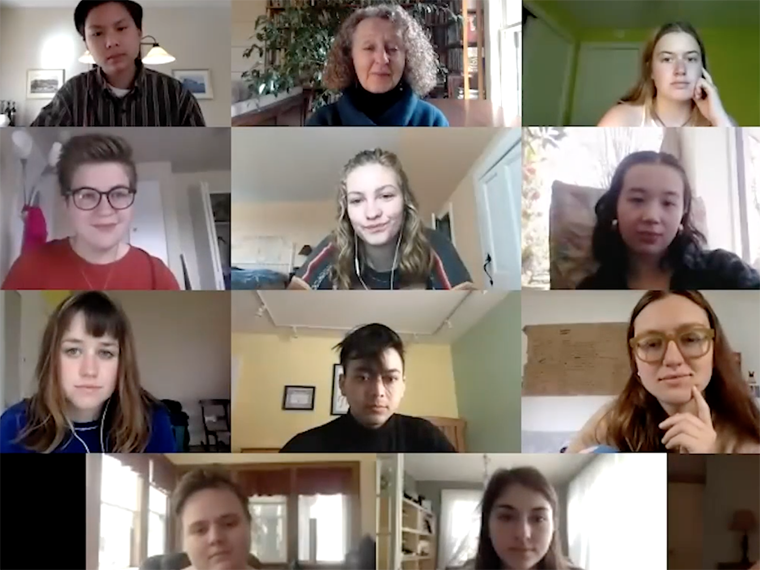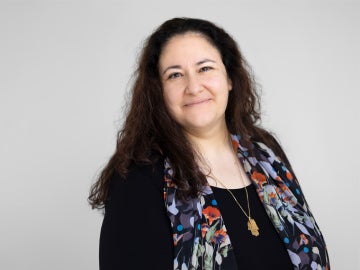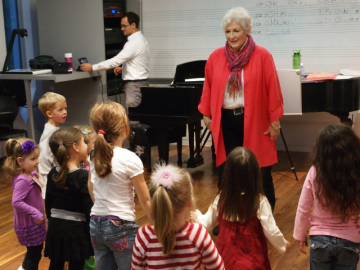Campus News
Teaching in the New Normal: 18+ Ways of Looking at Mt. Fuji
April 28, 2020
Communications Staff

Professor Lynn Powell's class reads haiku inspired by art in the Allen Memorial Art Museum's collection.
Photo credit: Courtesy of Lynn Powell
These days, the classroom has taken on new meaning for both faculty and students at Oberlin. In this series we are sharing stories from faculty on how they are navigating this new normal. How have you adapted instruction to a remote learning environment? How have students shifted how they learn and participate? What’s changed, what’s stayed the same, or what has come as a pleasant surprise? Please share an example or anecdote that addresses one of these areas.
Lynn Powell, director of Oberlin Writers in the Schools (WITS) and visiting assistant professor in creative writing, describes how her class worked with the Allen Memorial Art Museum’s Office of Academic Programs to remotely view Japanese woodblock prints as a companion activity to reading several poems. Powell shares that a surprising benefit of digital presentation of images is the ability to look at artwork much closer than during an in-person viewing. The resulting class discussion was so meaningful that the students wrote haiku inspired by the art.
From Powell:
About a quarter of the time, my creative writing class Word & Image: Poetry in Dialogue with Visual Art meets in the Allen Memorial Art Museum (AMAM). We spend class sessions in the galleries, and also in the Print Study Room with works I have requested that are not currently on view. The visit I most look forward to is the session we spend looking closely at woodblock prints by the Japanese masters Hiroshige and Hokusai. We always prepare for this visit by reading a range of poems—including Etheridge Knight’s haiku sequence about prison life and Wallace Stevens’ “Thirteen Ways of Looking at a Blackbird”—that illustrate how poets can explore a subject from multiple points of view. At the museum, we examine how artists use similar strategies. When we enter the Print Study Room, we’re met with more than a dozen gorgeous Mt. Fujis, from the famous, looming “Red Fuji,” to views where the distant mountain shrinks beneath a cherry blossom, is glimpsed through a barrel rolled by a workman, or is dwarfed by a foreground kite.
So how, I wondered, could we capture the magic of those prints without being in their presence? The answer was to work collaboratively with Hannah Kinney and Emma Laube ’17 of the museum’s Office of Academic Programs, along with Kevin Greenwood, the Joan L. Danforth Curator of Asian Art, to create an online experience that was remarkable in its own ways. Hannah and Emma produced a Prezi document of high-definition images of the prints for me to share with my students. During our online class discussion, Kevin provided salient cultural context and deftly guided us through a close look at those artworks.
But something special happened that couldn’t have happened in the Print Study Room: Kevin was able to zoom in on exquisite and illuminating details we might not have noticed on our own, and all 20 of us—Kevin, the 18 students, and myself—had equally perfect, front-row views of every detail. Our close engagement sparked such lively and meaningful discussion that at the end of class I invited the students to create haiku in response to one or more of the prints. During the next few days, as they added their haiku to a Google doc, a poetic sequence emerged that feels as vivid and communal as our experience of looking and talking together about art.
You can watch the class give a reading of the collaborative poem or read the haiku sequence, below, and see the print at the AMAM that inspired it.
See an image of each of these works by clicking on the title.
Tree peers over ledge
watching boats float towards Fuji —
trio doesn’t heed.
(after View of Konodai, no. 95, Hiroshige)
Do the waves wish they
were mountains, or do they want
to become the clouds?
(after Fuji between High Waves, Hiroshige)
— Kierra Nguyen
*
Mountain rises, floats
on yellow clouds, sun-lit sky.
Shoppers carry on.
(after Fuji from Surugacho, no. 8, Hiroshige)
— Anna Kozler
*
Blossoms frame the light
The sleepless river flows towards—
and away from you
(after Cherry Blossoms at Koganei in Musashi Province, no. 12, Hiroshige)
— Evan Lindberg
*
In the shadow of
bleak peaks, a valley blooming
with life’s rich color.
(after Autumn Flowers on the Otsuki Plain in Kai Province, number 31, Hiroshige)
— Alfie Parr
*
Spying on heaven
through an old cherry tree’s eye—
will it know my gaze?
(after Cherry Blossoms at Koganei in Musashi Province, no. 12, Hiroshige)
Ruddy mountain waits
for evergreen to encroach,
patient and willing.
(after Fuji in Clear Weather [Red Fuji], Hokusai)
— Jen Gallagher
*
A beautiful kite
soaring higher than Fuji—
maybe it’s grander.
What way does the wind blow here?
Cloud fingers reach up and out.
Grip tight, lay-men work.
All distinct until
ocean skies meet snow cap tops,
a beautiful blend.
(after Fuji from the Roof of Hongan Temple, Hiroshige)
— Kaitlyn Rivers
*
A lone turtle hung
in isolation heeds the
holy missed vistas.
(after Turtle Dangling from the Pole of a Vendor’s Tub on Mannen Bridge in Fukagawa, Hiroshige)
— Fudi Fickenscher
*
Big fish, you are here.
Through your immaculate blue
eye - see your sea seep.
(after Uidō Bridge and Surugadai, no. 63, Hiroshige)
— Elia Tzoukermann
*
Men crawling like ants
camouflaged on the sloped roof.
Behind them: a kite.
(after Fuji from the Roof of Hongan Temple, Hiroshige)
— Diana Montero
*
Mountain, drift over
to mourning that has no lease.
Wee townsfolk meet blue.
(after Dawn at Izawa in Kai Province, Hokusai)
— Ariana Hughes
*
Look! I am flying
high above the red blaze sky,
the white-capped ant hill.
(after Turtle Dangling from the Pole of a Vendor’s Tub on Mannen Bridge in Fukagawa, Hiroshige)
— Molly Bryson
*
Crystal clear expanse –
Elevate upon two peaks –
A moment of breath
(after Fuji from the Roof of Hongan Temple, Hiroshige)
— Anna Scott
*
Throng of faceless men,
backs turned to the darkest blue,
find her eye again.
(after Fuji from the Ford on the Oi River at Kanaya on the Tōkaidō, Hokusai)
This your canary
light that folds like fine fabric.
Mark her gaze of lonely ice.
(after Fuji from Surugacho, no. 8, Hiroshige)
— Maeve Woltring
*
The sky lays weary.
Heavy head meets sunken shoulder,
cradled by easing wake.
(after Sunset over Ryogoku Bridge, Hokusai)
— Toby Cochran
*
Briny arms of waves
raise holy sea-foam fractals
to birds’ blood-red sky.
(after Waves off the Satta Pass in Saruga Province, no. 23, Hiroshige)
— Claire Jenisch
*
You hide your greatness
through the eye of a needle
threaded by water.
(after Cherry Blossoms at Koganei in Musashi Province, no. 12, Hiroshige)
Unfurled before you,
sapphire-cerulean hue.
Reverence in blue.
(after Fuji from the Roof of Hongan Temple, Hiroshige)
Is your wind the same
as that which crashes the waves
lapping below you?
(after Fuji between High Waves from Shichiri Beach in Sagami Province, Hiroshige)
— Maya Rose Bater
*
My arms unanchored,
my shell betrays me, as it
ties me up, not down.
(after Turtle Dangling from the Pole of a Vendor’s Tub on Mannen Bridge in Fukagawa, Hiroshige)
— Xander Lee
*
A reclining arch,
fish scale walls, morning sunshine.
Reach out and touch it.
(after Turtle Dangling from the Pole of a Vendor’s Tub on Mannen Bridge in Fukagawa, Hiroshige)
— Cyrus Thelin
You may also like…
Remembering Former Visiting Assistant Professor Leila Ben-Nasr
Leila Ben-Nasr, a former visiting assistant professor of comparative American studies, died on November 28, 2025.
Oberlin Community Remembers a Beloved Retired Professor
A member of Oberlin faculty for 13 years, Peggy Bennett was known by students and the Oberlin community for creating and leading MusicPlay, a preschool classroom and learning lab run as part of the...
Eric Rooks Named Director of Campus Safety at Oberlin
Longtime public servant emphasizes collaborative partnerships and kindness.


